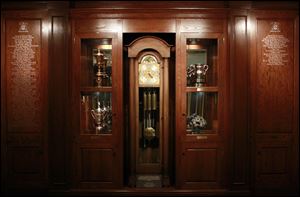
U.S. SENIOR OPEN
Timeless piece of Inverness history
7/24/2011
Players from the 1920 U.S. Open gave a clock to Inverness for opening its doors to them, something other private clubs did not. The clock is part of this year's U.S. Senior Open logo.
A large cathedral clock standing in the clubhouse lobby at Inverness Club isn't just there to tell time. It's there to tell a story.
This particular narrative dates back nearly 100 years to a period in golf history when private clubs still barred the game's professional competitors from entering their clubhouses during tournaments.
That all changed when Inverness hosted its first major championship, the U.S. Open, in 1920. To the club's members, the idea of rendering professional players as second-rate citizens would not only be wrong, but it would be an inaccurate portrayal of the principles Inverness stood for. So, behind the lead of president S.P. Jermain, the man most responsible for bringing the Open to Inverness, the club opened its doors to the 286-player field, inviting the golfers to use its lockerroom and dining area for those four days in August.
So appreciative of the club's generosity were the golfers that they pooled their funds to buy Inverness a chimed wooden clock, which sits in the lobby to this day, extending about eight feet from bottom to top, and remaining in good condition. Its relevancy remains intact, too, evidenced by the clock being incorporated into the official logo of this year's U.S. Senior Open.
"To remind people of the significant role that Inverness has played in golf history," championship director Judd Silverman said.
A plated inscription on the clock, coined by the donating golfers, reads:
"God measures men by what they are
Not what they in wealth possess
That vibrant message chimes afar
The voice of Inverness."
"It's something we're very proud of in terms of how it reflects upon at Inverness and the entire Toledo community," said the club's historian, Steve Kline.
This year's U.S. Senior Open will be the ninth major championship Inverness has hosted, and the club's second Senior Open.
The official announcement from the 1920 Open reads that "lockers will be reserved for all visiting players in the order of application" and "the golfers' dining room in the Club House will be reserved exclusively for meals for all contestants."
Winning the Open was Ted Ray of Great Britain, who finished one shot ahead of a foursome of runners-up that included Jack Burke, Sr., Harry Vardon, Leo Diegel and Jock Hutchison. In another example of just how much golf has evolved since the 1920s, Ray pocketed only $500 for the win, and the runners-up each took home just $188. Still, they didn't skimp in showing the club their appreciation.
Jeff Kimble, the Chief Operations Officer of the Toledo design firm Communica, was commissioned to create the logo for this year's event after doing the same in 2003 when Inverness hosted its first Senior Open. After scrapping a few executions, Kimble decided to move forward with a mark consisting of a scaled-down rendering of the clock in which he placed a picture of a golf ball where the chimes would normally be. The bottom third of the clock is covered by a sketch of the top left corner of the American flag.
"Most tour event's logos are real traditional looking, and some are not even done professionally," Kimble said. "I give Judd and his group a lot of kudos for allowing us to do something that kind of stands out in the crowd. I think this is unique."